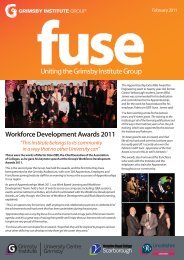Journal of Research & Scholarly Output 2006 - Grimsby Institute of ...
Journal of Research & Scholarly Output 2006 - Grimsby Institute of ...
Journal of Research & Scholarly Output 2006 - Grimsby Institute of ...
Create successful ePaper yourself
Turn your PDF publications into a flip-book with our unique Google optimized e-Paper software.
These mechanisms can range from the<br />
familiar indirect forms <strong>of</strong> involvement such<br />
as safety representatives and safety<br />
committees and plant or works councils, to<br />
safety circles, suggestion schemes, job<br />
enrichment and even team working,<br />
including HAZOP studies, where applicable.<br />
Once the workforce becomes actively<br />
involved in health and safety, the next step<br />
is monitoring the impact <strong>of</strong> this involvement<br />
upon health and safety performance. A<br />
range <strong>of</strong> active and reactive monitoring<br />
techniques can be utilised to critically<br />
assess whether worker involvement is<br />
having the desired effect. This leads directly<br />
into the final components <strong>of</strong> auditing and<br />
reviewing the systems in place, with a focus<br />
upon continuous improvement in all areas.<br />
Although is not realistic to suggest that<br />
organisations begin by subscribing to<br />
principles <strong>of</strong> self-management, what is<br />
needed is a period <strong>of</strong> experimentation as<br />
organisations attempt to introduce new<br />
systems for involving the workforce before<br />
deciding upon the most suitable techniques.<br />
These attempts should be founded upon<br />
continuous improvement, ultimately striving<br />
towards self-managed teams and the<br />
creation <strong>of</strong> an organisation that is highly<br />
flexible and resilient to change. This may<br />
appear to the cynic to be a somewhat<br />
idealistic crusade, yet it is only when we<br />
have a truly autonomous and competent<br />
workforce that we will be able to manage<br />
risks in a dynamic fashion.<br />
The future <strong>of</strong> WISH?<br />
So what does the future hold for WISH?<br />
Well, it is clear that WISH will be a high<br />
priority for many years to come, as a part <strong>of</strong><br />
the constant search for new initiatives to<br />
further drive down the rates <strong>of</strong> accidents<br />
and cases <strong>of</strong> ill health at work. It must be<br />
remembered that bringing about<br />
improvements in health and safety, and<br />
developing the safety culture within any<br />
organisation, is all about a focus on people,<br />
and without worker involvement and the<br />
ensuing commitment to safety initiatives, it<br />
unlikely that organisations will meet the<br />
tough targets and best value indicators for<br />
the health and safety system set out within<br />
the Revitalising Health and Safety Strategy<br />
(ODPM, 2000).<br />
,<br />
WISH will continue to remain high on the<br />
HSC’s / HSE’s agenda as a part <strong>of</strong> the<br />
ongoing commitment to behavioural safety<br />
and the s<strong>of</strong>t systems approach. Indeed, the<br />
HSE will undoubtedly continue to build upon<br />
the work established by the Workers Safety<br />
Advisors (WSA) initiative in 2002, which<br />
tested ways <strong>of</strong> encouraging greater<br />
employee involvement in health and safety.<br />
This was another excellent example <strong>of</strong><br />
where partnerships between trade unions,<br />
employers and workers can lead to<br />
improvements in organisations that did not<br />
have trade union recognition. The pilot ran in<br />
four sectors (automotive engineering,<br />
construction, hospitality and the voluntary<br />
sector) and two thirds <strong>of</strong> the employers<br />
participating in the pilot had less than<br />
twenty-five employees. Changes to the<br />
approach to health and safety were reported<br />
by some three quarters <strong>of</strong> the employees<br />
FOCUS Page Page 43

















